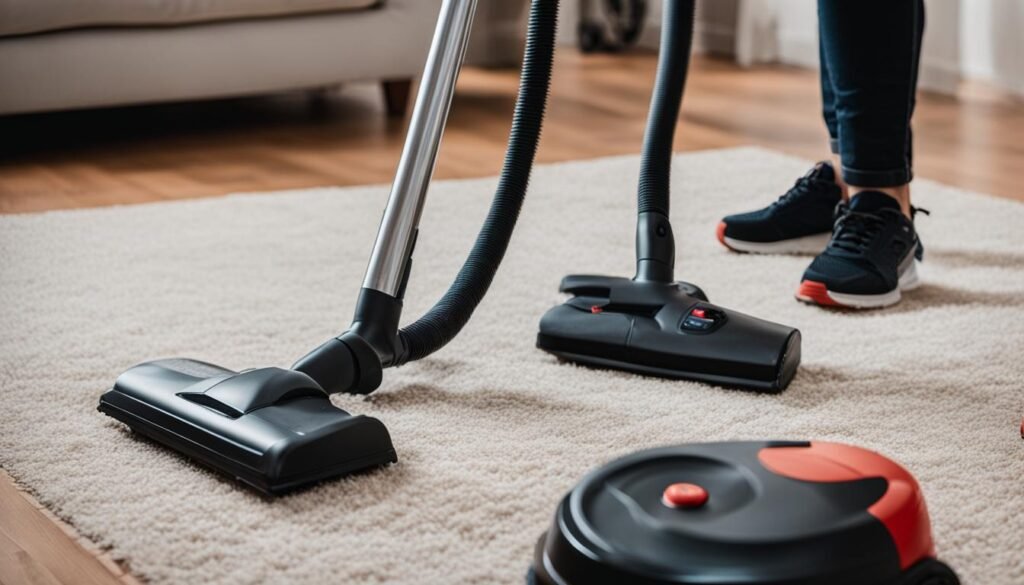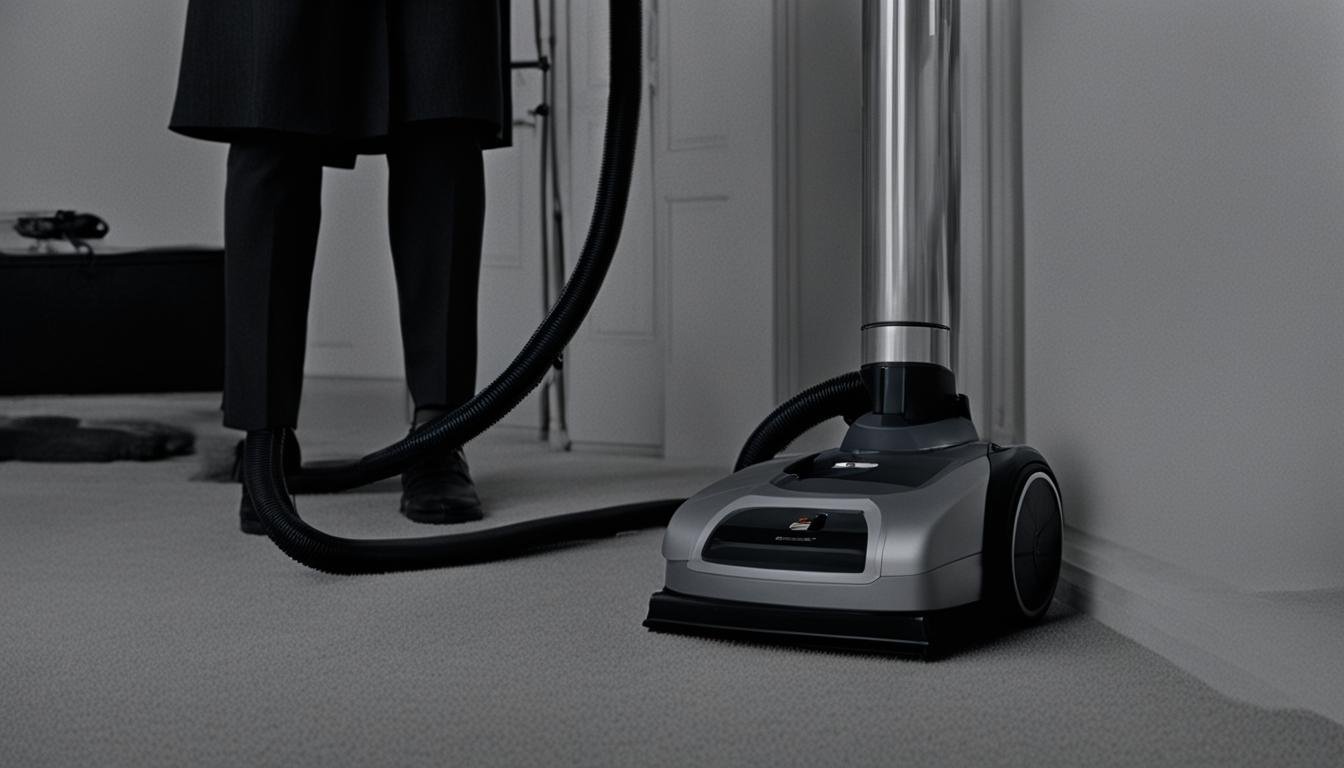Vacuuming may seem like a simple task, but it can actually lead to serious injuries if not done properly. Upright vacuums, which are the most common type, can cause strains and repetitive stress injuries to the wrist, rotator cuffs, lower back, biceps, shoulder, and elbow.
To avoid these injuries, it is important to know how to prevent injuries while pulling the vacuum cleaner by using proper technique, including standing up straight, using the body’s weight as a counterweight, switching hands, and taking breaks to prevent repetitive motion.
Backpack vacuums can also reduce strain by shifting the weight to the hips. Additionally, it is essential to check and replace damaged cords, avoid vacuuming liquids, and use the appropriate footwear for protection while vacuuming.
Key Takeaways:
- Proper technique and posture can help prevent injuries while vacuuming.
- Using backpack vacuums can reduce strain on the wrists, back, and shoulders.
- Regularly check and replace damaged cords to avoid electrical accidents.
- Avoid vacuuming liquids and use proper footwear for protection.
- Take breaks and switch hands to prevent repetitive stress injuries.
How to prevent injuries while pulling the vacuum cleaner?
When operating a vacuum cleaner, there are several important safety precautions to follow.
1. Wear appropriate footwear: Protect yourself against sharp objects and reduce the risk of slipping on freshly vacuumed floors by wearing slippers or shoes.
2. Use compatible charging cords: Prevent overloading and overheating by using only the charging cords designed for your specific vacuum cleaner model.
3. Avoid oversized or sharp debris: To prevent blockages and damage to your vacuum, do not attempt to vacuum debris that is too large or sharp.
4. Do not vacuum liquids: Unless you have a wet/dry vacuum explicitly designed for liquids, refrain from vacuuming any liquids to avoid electrical hazards.
5. Regularly empty the canister or dustbin: Maintain optimal suction power and prevent motor damage by emptying the canister or dustbin on a regular basis.
6. Avoid vacuuming flammable materials: Flammable materials can pose a fire risk, so it is important to refrain from vacuuming them.
7. Proper storage and maintenance: Store your vacuum cleaner in a cool, dry place when not in use. Perform regular maintenance tasks such as cleaning filters and checking for leaks or broken parts to ensure safe and efficient operation.
By following these safety precautions, you can avoid accidents and ensure a safe vacuuming experience. Remember, your well-being should always be a top priority.
Expert Tip:
“Regularly inspecting your vacuum cleaner for any signs of wear and tear can help prevent accidents and prolong its lifespan. Be proactive in identifying potential issues and address them promptly to maintain safe and effective vacuuming.”
Tips for Preventing Injuries While Pulling the Vacuum Cleaner
To prevent injuries while pulling the vacuum cleaner, it is important to use proper body mechanics. Engage your core muscles, bend your knees, and distribute the weight from your back leg to your front leg while pushing and pulling the vacuum. Avoid twisting and reaching by using a weight shift motion instead. Keep your neck and shoulders relaxed, and minimize pushing with your shoulder to reduce the risk of impingement. Take smaller strokes with the vacuum to maintain stability and prevent injuries.
If you experience muscle strain, there are several stretches you can do while vacuuming. The doorway stretch, where you place your forearms against a doorway and lean forward, can help stretch your chest and shoulders. The single knee to chest stretch, where you lie on your back and bring one knee towards your chest, can alleviate lower back discomfort. The supine piriformis stretch, performed by lying on your back and crossing one ankle over the opposite knee and pulling the knee towards your chest, can help loosen tight hip muscles.
Regular exercise and warm-up routines can also help prevent injuries while vacuuming. Incorporate exercises that strengthen your core, back, and leg muscles to improve stability and reduce strain. Before vacuuming, take a few minutes to perform simple stretches for your neck, shoulders, back, and legs to warm up your muscles and increase flexibility.
By implementing these tips, you can stay injury-free while pulling the vacuum cleaner and maintain a safe and efficient cleaning routine.

| Common Injuries Associated with Vacuuming | Tips to Prevent Injuries |
|---|---|
| Strains and repetitive stress injuries to the wrist, rotator cuffs, lower back, biceps, shoulder, and elbow | Use proper body mechanics, engage core muscles, bend knees, and distribute weight evenly |
| Neck and shoulder strain from improper pushing techniques | Minimize pushing with the shoulder, take smaller strokes with the vacuum |
| Muscle strain from overexertion | Perform stretches while vacuuming, incorporate regular exercise and warm-up routines |
Conclusion
Preventing injuries while using the vacuum cleaner is crucial for maintaining a safe and healthy home environment. By implementing proper safety precautions and techniques, you can significantly reduce the risk of strains, repetitive stress injuries, and accidents.
Remember to always prioritize your body mechanics while pulling the vacuum cleaner. Engage your core muscles, distribute the weight properly, and avoid twisting or reaching. This will help minimize the strain on your back, shoulders, and knees.
In addition to using the right techniques, don’t forget to wear appropriate footwear for protection and stability. Avoid vacuuming liquids or flammable materials, as they can pose a serious safety risk. Regularly inspect and maintain your vacuum cleaner to ensure optimal functioning and prevent any potential hazards.
By following these injury prevention strategies, you can enjoy a clean home without compromising your well-being. Keep these tips in mind and make vacuuming a safe and efficient task in your daily routine.
FAQ
How can I prevent injuries while pulling the vacuum cleaner?
To prevent injuries while pulling the vacuum cleaner, use proper body mechanics. Engage your core muscles, bend your knees, and distribute the weight from your back leg to your front leg while pushing and pulling the vacuum. Avoid twisting and reaching by using a weight shift motion instead. Keep your neck and shoulders relaxed, and minimize pushing with your shoulder to reduce the risk of impingement. Take smaller strokes with the vacuum to maintain stability and prevent injuries.
What safety precautions should I follow while vacuuming?
When operating a vacuum cleaner, there are several important safety precautions to follow. Wear slippers or shoes to protect against sharp objects and to reduce the risk of slipping on freshly vacuumed floors. Use only compatible charging cords for your vacuum cleaner to prevent overloading and overheating. Avoid vacuuming oversized or sharp debris, as they can cause blockages or damage to the vacuum. Do not vacuum liquids unless you have a wet/dry vacuum specifically designed for that purpose. Regularly empty the canister or dustbin to maintain optimal suction power and prevent motor damage. Avoid vacuuming flammable materials, as they can pose a fire risk. Store the vacuum cleaner safely in a cool, dry place, and perform regular maintenance such as cleaning filters and checking for leaks or broken parts.
What are some tips to prevent injuries while using the vacuum cleaner?
To prevent injuries while using the vacuum cleaner, it is important to use proper technique. Stand up straight, use the body’s weight as a counterweight, switch hands, and take breaks to prevent repetitive motion. Backpack vacuums can also reduce strain by shifting the weight to the hips. Check and replace damaged cords to avoid accidents. Avoid vacuuming liquids, as it can be dangerous. Use appropriate footwear for protection while vacuuming. Regular exercise and warm-up routines can also help prevent injuries while vacuuming.
How can I avoid getting hurt when pulling the vacuum cleaner?
To avoid getting hurt when pulling the vacuum cleaner, use proper body mechanics. Engage your core muscles, distribute the weight from your back leg to your front leg, and avoid twisting and reaching. Take smaller strokes with the vacuum to maintain stability. Use the weight shift motion instead of pushing with your shoulder to reduce the risk of injuries. It is also important to take regular breaks, stretch, and maintain overall physical fitness.
How can I stay injury-free while pulling the vacuum cleaner?
To stay injury-free while pulling the vacuum cleaner, follow proper technique and safety precautions. Use proper body mechanics, wear appropriate footwear, and avoid vacuuming liquids or flammable materials. Regularly maintain and inspect your vacuum cleaner to ensure optimal performance and reduce the risk of injuries. Be mindful of your body’s position and take breaks when needed. By implementing these safety measures, you can keep your home clean without putting your well-being at risk.
What are some safe vacuuming techniques?
When vacuuming, it is important to use safe techniques to prevent injuries. Stand up straight, distribute the weight evenly, and use the body’s weight as a counterweight to reduce strain. Switch hands periodically to avoid overworking one side of the body. Take breaks to rest your muscles and prevent repetitive motion injuries. Use shorter and more controlled strokes with the vacuum to maintain stability and reduce the risk of falls or muscle strain.





Leave a Reply